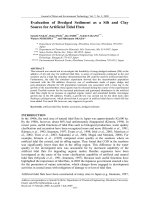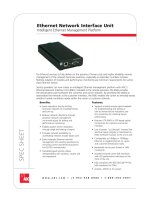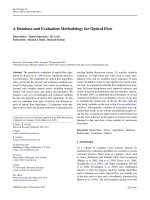Toward a network and traffic monitoring and management platform for software defined networks (SDN)
Bạn đang xem bản rút gọn của tài liệu. Xem và tải ngay bản đầy đủ của tài liệu tại đây (884.41 KB, 5 trang )
Journal of Science & Technology 136 (2019) 050-054
Toward a Network and Traffic Monitoring and Management Platform for
Software Defined Networks (SDN)
Nguyen Tai Hung*
Hanoi University of Science and Technology – No. 1, Dai Co Viet Str., Hai Ba Trung, Ha Noi, Viet Nam
Received: April 17, 2019; Accepted: June 24, 2019
Abstract
BKMON is a software tool designed to provide an independent monitoring solution for SDN network
controllers with scalable capabilities. Therefore, it extends monitoring capabilities based on the network
controller by providing visual graphs with information on each switch or port of the switch or even on specific
traffic flow. Network monitoring helps to avoid interruption and system’s failure during the operational
process, thus, physical errors such as cable breaks or network node failures can be detected and fixed
quickly. Those examples show how important network monitoring systems are and furthermore, the
complexity and extensibility of the current network makes monitoring an extremely difficult task. Finally, the
deployment of new technologies, like SDN, in the network makes it even more challenging. BKMON was
defined and prototyped in the direction that will partly provide solutions to this scientific and technological
challenge.
Keywords: SDN, network monitoring, openflow, northbound API, RESTFul.
1. Introduction*
Software Defined Network (SDN) [1] enables
highly programmable networks with a high level of
transparency unlike traditional networks allowing the
management of flows on each component in the
network. Network impairments can be calculated
using statistical information provided by each SDN
enabled switch. Unfortunately, borrowing monitoring
techniques developed for traditional networks and
placing them in SDN, may cause a large overhead
due to large amount of queries exchanged between
the controller and switches in the network. New
techniques should be developed in order to reduce the
amount of resources required to monitor application
specific traffic. One approach to minimize the
overhead is to filter out traffic based on feedback
arriving directly from the business application, so that
the application becomes the main source of
information used to decide on which flows in the
network should be monitored. Based on this feedback
we can identify switches that require monitoring. The
management decisions are still made by the
controller, not the service itself, however, the
controller gains greater visibility in the network.
Ideally the monitoring and decision making should be
completed without the need for packet classification.
This paper presents BKMON: an SDN monitoring
platform equipped with out-of-the-box techniques
used to identify traffic unit like: packets, flows and
ports together with its statistic collected from SDN
switches through Openflow protocol.
In any size of the computer networks,
management and monitoring have always played an
important role in process of operating, exploiting and
ensuring network’s efficiency. Determining critical
state parameters of network components is essential
for evaluation of network system. In practice,
network monitoring usually means regular
measurement and collection of many network-related
parameters such as bandwidth usage or delay between
nodes. Moreover, other parameters based on network
nodes such as connection status or packet loss are
important indicators to indicate if everything in the
network works as expected. Nowadays, monitoring
tools furtherly strive to provide information that can
be later used to evaluate the Quality of Service (QoS),
detect faults and improve security. Traffic monitoring
in traditional networks is a well-researched area,
where many applications were developed in order to
aid network administrators in their day-to-day
operations. Some of them include solutions built with
the use of packet sampling or Deep Packet Inspection
(DPI) implemented in software or hardware.
However, while trusted by in industry the
computational requirements of traffic monitoring
continue
to
impact
network
performance
significantly.
*
Corresponding author: Tel.: (+84) 903217248
Email:
50
Journal of Science & Technology 136 (2019) 050-054
and accurate. The packet flow sampling mechanism
carried out by each sFlow instance must ensure that
any packet observed at a data source has an equal
chance of being sampled, irrespective of the packet
flow to which it belongs. Taking a sample involves
either copying the packet’s header, or extracting
features from the packet. The biggest drawback of
sFlow, as well as Cisco’s NetFlow is that all devices
in the network need to support those technologies for
a comprehensive and complete network analysis.
OpenNetMon [5] - OpenFlow based controller
module uses the idea of per-switch monitoring to
enable fine-grained traffic engineering. In order to
obtain network metrics, probe packets are send every
measuring round. However, it is not possible to
measure the performance of each link on a per-flow
basis, but only the performance of probe packets
being injected onto each path in the network, where
there could be many flows in one path. In another
work [7] authors propose the per-link monitoring and
investigate the ability for the SDN controller to report
intermediate MOS (iMOS) for a given set of calls by
calculating accurate loss rates and using the
simplified Emodel formula detailed in the paper. That
work uses OpenFlow switch statistics request, and
evaluates the cost associated with sending such
messages to all switches in the network. It establishes
that the overhead is very low, yet it linearly increases
as the number of switches in the network increase.
The limitation of that work is that every active and
non-active switch is queried every second, and even
that it outperforms OpenNetMon as no probe packets
are injected, other methods for flow selection should
be developed in order to reduce the overhead.
2. The survey of previous works on SDN network
management
As said above, network monitoring is generally
an important topic but is often underestimated.
Network systems are often monitored with multiple
mechanisms; For example, measuring latency using
ICMP (Internet Control Message Protocol) or
querying network node via SNMP (Simple Network
Management Protocol). However, these applications
need to be adjusted and tested in distributed ways.
Therefore, a centralized monitoring server system
like Zabbix [2] or Nagios [3] is needed.
In recent years, there are many open source
SDN controllers available but OpenDaylight and
Floodlight are the most popular ones. Although they
support general network monitoring capabilities such
as gathering information about switches and traffic
through them. However, the form of information
provided is not a readable for normal people and also
do not provide understanding of current network use.
So many previous studies have tried to overcome this
with many proposals and solutions for monitoring
network based on SDN technology. But most of
previous studies focused on measuring and proposing
different processes to increase the accuracy during
measurement period. In addition, a number of studies
have introduced a control module to expand
Controller and interaction directly with packet
forwarding process. Some other studies only describe
few researches samples, not suitable for testing and
not implemented with utility software. For example, a
few selected researches done before about this SDN
monitoring mechanisms and tools are as below.
In contrast, BKMON software presented on this
article introduces a monitoring method (northbound
API) of the controller. This software is fully separate
from network components and acts as an extension to
monitor network usage.
Jarschel et al. [4] shows the benefits of
application control plane, where applications running
on top interact with the network itself. The
application-state information is used by the controller
to choose the best path in the network. Authors were
able to achieve reduced bandwidth consumption in
the initial ramp-up stages of the transmission when
applying to the YouTube streaming application,
which is very dynamic, just like VoIP traffic. The
initial results were satisfactory however, this
approach requires dedicated machine or array of
machines used to gather helpful information from the
running applications and additional computing
resource in the control plane to perform packet
analysis task. sFlow, can be used to monitor businesscritical applications such as voice, data, video,
without having to employ multiple monitoring
applications for that purpose. sFlow is implemented
in hardware (network switches/routers) and hence it
can operate at line speeds without impacting the
switch performance considerably. The sampling is
done at the hardware ASICs, which makes it simple
3. BKMON – an Integrated Architecture for
Monitoring SDN Networks
The main idea of BKMON is to implement a
network monitoring software that is not only
independent of Controller and Switches in the
network but also has the ability to monitor and
provide specific visualization. Therefore, BKMON
does not enforce the flow measurement method
which depends on network equipment such as switch,
port and traffic frequency, defined by the OpenFlow
standard and can be queried and collected by any
SDN controller. BKMON is a business application on
the network application layer of the SDN model
described in Fig. 1.
51
Journal of Science & Technology 136 (2019) 050-054
the OpenFlow v1.3 specifications. Therefore, the
function of data model transformation obtained by
SDN controller does not standardize REST API into
BKMON's data model provided by specific REST
clients in the data access layer. The top layer contains
a graphical interface for user interaction and for
graphically show of the collected data. It is a
collection of GUI (graphic user interface), tables,
graphs or series of options for monitoring and
managing network components and traffic. Many
tables and charts present flow graphics and
performance indicators in real time.
BKmon
Applications
Charts
GUI
Calculation
Metrics
Counter
Topology
DB Connector
Module REST API
File
…
Client
Data Base
Control Logic
POX
Client
OOL
Client
Floodlight
Client
Data File
4. Results and discussion
During the development of BKMON, virtual
testing environment based on simulating network on
Mininet and using Floodlight SDN controller. This
testing environment includes two virtual machines
(VMs) with Ubuntu version 14.04 Linux operating
system added in VMware Workstation Hypervisor on
Windows 10 Professional system. The first virtual
machine contained a Mininet emulator. Mininet is
conFig.d with a topology tree with two levels as
described in Fig. 1. During the entire development
process, this topology is used on regular basis to get
the return parameters from SDN controller. SDN
controller is packaged in the second virtual machine
and developed directly on the Windows server
operating system using Java and Eclipse. At the last
stage, BKMON is fed into the real network where
SDN Controller will connect to the Gateway with real
network traffic to be able to measure and monitor the
real network traffic.
Northbound API
POX
OpenDaylight
Floodlight
Control layer
Southbound API
Infrastructure
Fig. 1. BKMON Architecture
It interacts with the interface (northbound of
SDN controller) through a special application
programming interface or API. The architecture of
BKMON is based on the classification of software
architecture. The lowest layer is the data access layer,
which includes databases (SQL database), I/O files
and REST (Representation state transfer). This layer
provides the basic functions needed for
communication with SDN controller. Most open
source implementations of SDN controller provide a
REST-based Northbound API interface, enabling the
creation of an independent language programming
interface for network applications. This interface is
also used to develop BKMON and allow it to connect
to SDN controller. Therefore, the architecture of
BKMON contains a logical class called Module
REST API, which defines the methods and data
models provided by specific communication modules
with related SDN controller. The above layer includes
data models, which calculates performance indicators
using the statistical data provided by SDN controller.
Floodlight controller is chosen to deploy
BKMON, because it is widely used in research and
development environment. However, OpenDaylight
was also tested and showed that there is no major
technical problem because it also uses REST API for
Northbound. So most of the functional blocks of
BKMON are built on the Java language. BKMON’s
function is demonstrated in Fig. 2.
SDN controller also provides information
through OpenFlow protocol from network nodes.
However, the data model is formed by three main
factors; the first is the network topology that includes
all network devices (hosts, controller, switches and
their connections). Secondly, counters contain
statistical data. The final component is the metric,
which is used to estimate network performance.
Topology and counter models are mainly based on
Fig. 2. Functionalities of BKMON
52
Journal of Science & Technology 136 (2019) 050-054
Basically, BKMON has three main functions of
device monitoring, traffic monitoring and network
management
In device monitoring category, we managed the
following information.
Controller monitoring: IP address, memory
usage, status (yes as working normally), list of
modules used by controller.
Other devices monitoring: list down information
of all devices found by controller, which consists of
Switch OpenFlow and Host.
Fig. 4. Main GUI of BKMON
Switch monitoring: Real time statistics about
switch’s physical information, traffic on ports and
flows. We use two Openflow 1.3 messages to collect
these statistics from respective counters on switches,
which are: StatsReq and StatsRes [9]
For network management function, it does
following features:
- Collecting information to build and show the
network topology
- Switch’s flow entries management: help us
PUSH or DELETE a static flow in switch’s flow
table
- Firewall rules management: provide
options to set up our own rules.
many
Fig. 5. Chart of packets counter of specific port of a
Switch
For traffic statistics: This funtions support users
to identify byte rate, packet rate on all ports or
specified port in real-time; Also, BKMON uses the
SQLite database platform built into firefox browser to
stores parameters of all flows that go through
switches for later statistical analysis and dashboard
showing. In addition, BKMON also saves all
switches’s metric in the network that scanned by
controller.
5. Conclusion
Network management and monitoring the daily
network operation are always important topics in
research. Furthermore, managing and monitoring the
network that utilizes new technologies is extremely
difficult. BKMON software is designed and built with
the goal of providing a tool for easy managing the
components in the network as well as monitoring the
status of all hosts, network devices and especially the
traffic in the network. BKMON currently only runs in
one network domain controlled by a single controller,
but it is fully configurable to connect to more
controllers and thus allows it to monitor in the interdomain network environment. In addition, BKMON
can also be further invested to develop it in to the
commercial products with more advanced and
pragmatically features such as mobile alerting when
some emergency events occur, etc. This paper
provides design descriptions, functions that makes up
BKMON and shows the results of running BKMON
test in the lab of the Information Technology Center
at the Central Party Committee Office.
Figures below show the GUI and charts of
various counters of traffic and switches collected by
BKMON.
Fig. 3. Login Interface of BKMON
53
Journal of Science & Technology 136 (2019) 050-054
[5] N. L. Van Adrichem, C. Doerr, and F. A. Kuipers,
Opennetmon: Network monitoring in openflow
software-defined networks, in NOMS. IEEE, 2014.
Acknowledgements
The results of work presented on this paper are
possible due to the sponsorship of the National
Research Project titled of “Research and development
of Internet of Things (IoT) platform, application to
management of high technology, industrial zone”,
coded as KC.01.17/16-20”
[6] C. Thorpe, C. Olariu, and A. Hava, imos: Enabling
voip qos monitoring at intermediate nodes in an
openflow sdn, in SDS. IEEE, 2016.
[7] B. Siniarski, C. Olariu, P. Perry, and J. Murphy,
Openflow based voip qoe monitoring in enterprise sdn,
in IM. IEEE, 2017.
References
[1] />oads/sdn-resources/IEEE-papers/evolution-of-sdn-andof.pdf
[8] Grover, N., Agarwal, N., Kataoka, K. liteflow:
Lightweight and distributed flow monitoring platform
for sdn. In: Network Softwarization (NetSoft), 2015
1st IEEE Conference on. 2015, p. 1–
9.doi:10.1109/NETSOFT.2015.7116160
[2] />[3] />
[9] />
[4] M. Jarschel, F. Wamser, T. Hohn, T. Zinner, and P.
Tran-Gia, Sdnbased application-aware networking on
the example of youtube video streaming, in EWSDN.
IEEE, 2013, pp. 87–92.
-layer/statsrequest/
54









